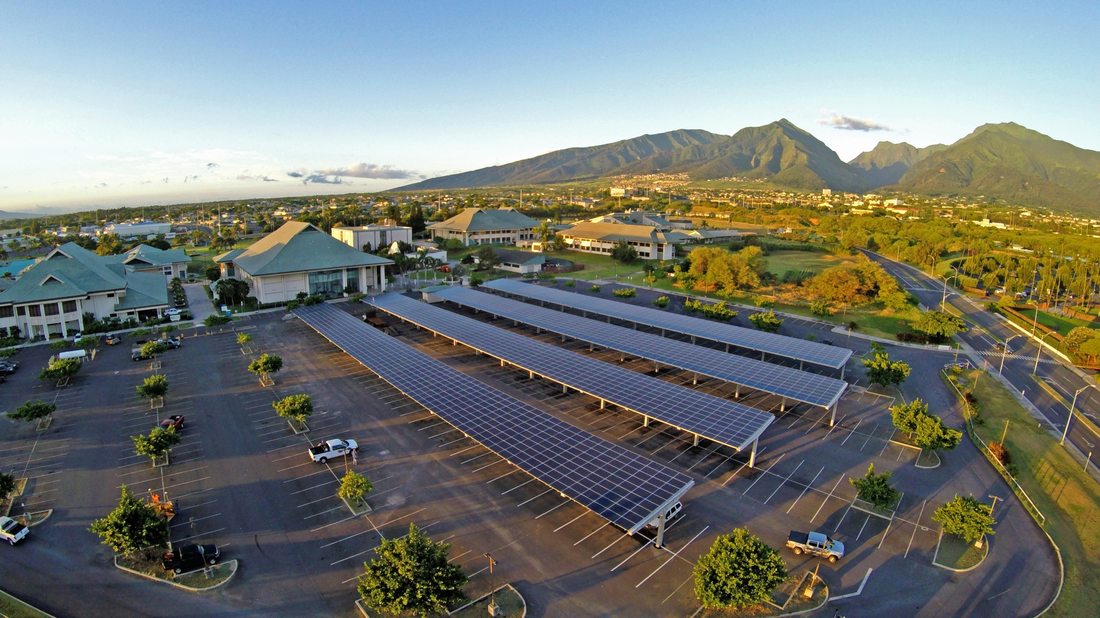
Over 750kW of PV carports installed at UH Maui College by HNU Energy was the first major step toward UH Maui College’s vision to become the nation’s first net-zero college campus. Courtesy HNU Energy.
By George Harvey
In June of 2015, Governor David Ige of Hawaii signed a set of laws relating to the state’s electric power. One of them set out a requirement that by 2045 all electric generation in the state had to be from renewable sources. That was sufficiently remarkable that many people did not notice another very progressive law about renewable power. It made it mandatory for the University of Hawaii (UH) to have all ten of its campuses use net-zero electricity by 2035. This meant that the university will have to produce, from renewable sources, at least as much electricity as it uses.
Progress on fulfillment of that law has been rapid. In fact, construction of the first net-zero buildings began only a little more than a month after the law was signed, at the UH Manoa campus, in Honolulu. The building, which had clearly been planned before the law was passed, opened in November of 2016. The Manoa campus, incidentally, was where Governor Ige had earned his Bachelor of Science degree in Electrical Engineering.
Another campus that has been making news is UH Hilo, on the “Big Island” of Hawaii. UH Hilo has a variety of initiatives underway, ranging from solar photovoltaic systems and lighting, to battery backup. The overall goal of the campus is to go beyond net-zero electricity to being entirely carbon neutral by 2050.
The most ambitious short-term goal, however, might be at the UH Maui College campus. UH Maui is on track to get to net-zero electric use by 2020, at the latest. In fact, people on the campus have hopes to reach that goal in 2018. If it can achieve that goal, it will probably be the first college campus in the United States to do so.
HNU Energy was the solar installer for the Hilo and Maui campuses. HNU Energy installed over half a megawatt of PV at UH Hilo and over three quarters of a megawatt of PV carports at UH Maui. Dr Michael Reiley, President of HNU Energy states, “HNU Energy is committed to exceeding Hawaii’s aggressive renewable energy goals, beginning with making UH Maui the nation’s first net-zero college campus. We couldn’t be prouder of the leadership the University of Hawaii Maui College is demonstrating in sustainability and renewable energy generation and storage.”
There are strong financial incentives for the UH campuses to get to their legally required goal well ahead of schedule. The cost of electricity in Hawaii is among the highest in the nation. In fact, residential rates range from a little over 26¢/kWh on Oahu, the island Honolulu is on, to a little over 31.5¢/kWh on the island of Hawaii, which has commercial rates ranging upwards from over 18¢/kWh. This is because there is no local source of fossil fuels, and historically electricity has been generated with oil, brought in by ship.
Fortunately for the people of Hawaii, there are other resources. The state’s abundant sunshine makes it possible to get quite a lot of sunshine out of a solar array. This lowers the cost of solar power into the range of being very affordable, even by the standards of the rest of the country. The current levelized cost of electricity (LCOE) for utility-scale solar power with battery backup is about 8.2¢/kWh, according to Lazard Associates (http://bit.ly/LCOE-2017). With its sunshine, Hawaii’s average costs for solar power should be lower than that of the nation as a whole. This means the payback period for the UH campuses would probably be very short.
Many thanks to our sponsor:









Leave a Reply